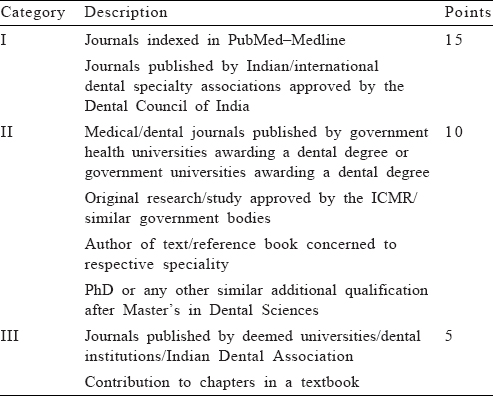Translate this page into:
Dental Council of India Criteria for Research Publications: Need for revision
2 Department of Public Health Dentistry, Bharati Vidyapeeth Dental College and Hospital, Sangli, Maharashtra, India
Corresponding Author:
Umesh Wadgave
Department of Public Health Dentistry, ESIC Dental College, Kalaburagi, Karnataka
India
dr.w.umesh@gmail.com
| How to cite this article: Wadgave U, Khairnar MR. Dental Council of India Criteria for Research Publications: Need for revision. Natl Med J India 2020;33:62 |
The publication record in any academic institution is a key factor for jobs, promotion and funding opportunities. The culture of ‘Publish or Perish’ has led to a surge in unethical practices of ‘pay and publish trash’ in academic institutions of India.[1] Today, there are several dubious journals publishing articles for profit without scrutinizing their scientific validity. These journals have been called predatory or pseudo journals.[2] Several surveys have revealed that a majority of the world's predatory journals and predatory authorship are based in India.[3],[4],[5],[6],[7] The major reasons behind this problem are the regulations of mandatory publications for jobs/promotions, incentives for publication in institutions, incompetence of researchers, inadequate funds and infrastructure, commercialization of research publishing and lack of evaluation system of research publications at the institution and national levels.[1],[4],[5] The University Grants Commission (UGC), a statutory body of the Government of India, has taken this matter seriously and formed the Consortium for Academic Research and Ethics (CARE) to promote research integrity in India.[8]
Predatory journals are also found in dentistry. Considering the obvious practice of predatory publishing in dental colleges of India, the Dental Council of India (DCI), the statutory body which regulates dental education in India, should revisit the criteria related to publication. Currently, the DCI guidelines consider only PubMed/Medline-indexed journals in category I [Table - 1].[9] However, it does not mention specifically about other databases including reliable databases such as Scopus and Web of Science. On the other hand, Scopus and Web of Science-indexed journals are considered by national academic regulatory organizations such as the UGC-CARE list of approved journals by UGC and National Institutional Ranking Framework (NIRF), an initiative of the Ministry of Human Resource Development.[10],[11] These differences in the guidelines of various statutory bodies of India regulating academic institutions create confusion among dental researchers in choosing journals for publication.

The other concern is regarding category III of the publication guidelines by the DCI, which considers journals published by deemed universities/dental institutions/Indian Dental Association [Table - 1]. In essence, journals indexed in any database are considered under this category without distinguishing between predatory and legitimate journals. Such blanket approval provides ample scope for predatory publishing. Thus, it is necessary to revise the DCI guidelines to bring them in consonance with the UGC-CARE and NIRF policies. The revision is necessary to prevent confusion in choosing a journal and also to prevent publication of research in predatory journals. The DCI should also institute different measures to control the predatory publishing in dental institutions of India.
Conflicts of interest. Nil
| 1. | Seethapathy GS, Santhosh Kumar JU, Hareesha AS. India's scientific publication in predatory journals: Need for regulating quality of Indian science and education. Curr Sci 2016;111:1759–64. [Google Scholar] |
| 2. | Severin A, Low N. Readers beware! Predatory journals are infiltrating citation databases. Int J Public Health 2019;64:1123–4. [Google Scholar] |
| 3. | Shen C, Björk BC. ‘Predatory’ open access: A longitudinal study of article volumes and market characteristics. BMC Med 2015;13:230. [Google Scholar] |
| 4. | Demir SB. Predatory journals: Who publishes in them and why? J Informetr 2018;12:1296–11. [Google Scholar] |
| 5. | Xia J, Harmon JL, Connolly KG, et al. Who publishes in ‘predatory’ journals? J Assoc Inf Sci Technol 2015;66:1406–17. [Google Scholar] |
| 6. | Bohannon J. Who's afraid of peer review? Science 2013;342:60–5. [Google Scholar] |
| 7. | Moher D, Shamseer L, Cobey KD, Lalu MM, Galipeau J, Avey MT, et al. Stop this waste of people, animals and money. Nature 2017;549:23–5. [Google Scholar] |
| 8. | Patwardhan B. Why India is striking back against predatory journals. Nature 2019;571:7. [Google Scholar] |
| 9. | Dental Council of India. Acts, Rules and Regulations. Available at www.dciindia. gov.in/Rule_Regulation/MDS_Course_Regulations_2017.pdf (accessed on 23 Jan 2020). [Google Scholar] |
| 10. | Patwardhan B, Thakur A. UGC-CARE initiative to promote research quality, integrity and publication ethics. Curr Sci 2019;117:918–19. [Google Scholar] |
| 11. | National Institutional Ranking Framework Methodology for Ranking of Academic Institutions in India, Ministry of Human Resource Development. Available at www.nirfindia.org/Home (accessed on 23 Jan 2020). [Google Scholar] |
Fulltext Views
5,104
PDF downloads
1,236




